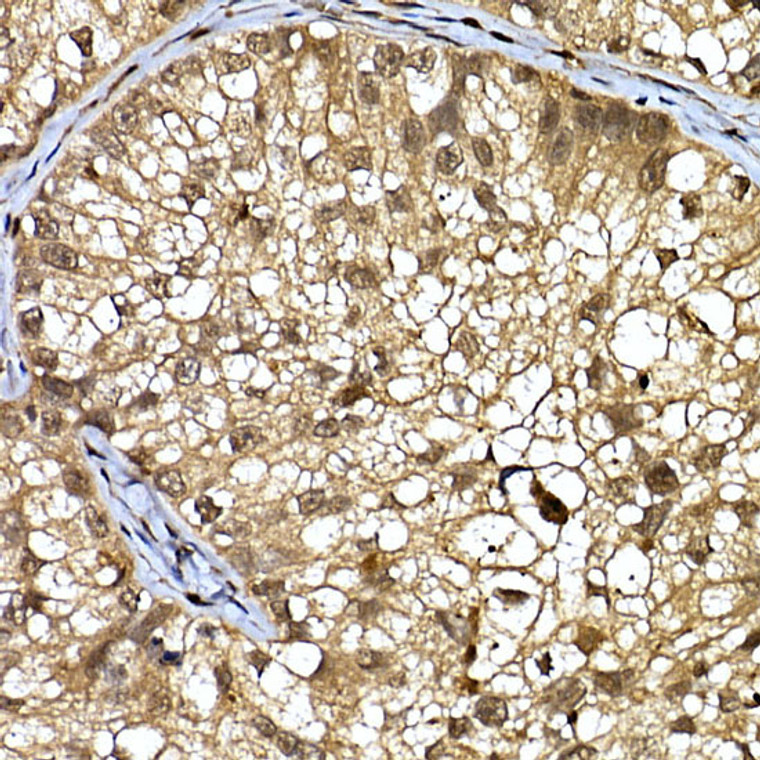| Host: |
Rabbit |
| Applications: |
WB/IHC/IF |
| Reactivity: |
Human/Mouse/Rat |
| Note: |
STRICTLY FOR FURTHER SCIENTIFIC RESEARCH USE ONLY (RUO). MUST NOT TO BE USED IN DIAGNOSTIC OR THERAPEUTIC APPLICATIONS. |
| Short Description: |
Rabbit polyclonal antibody anti-DCAF7 (1-342) is suitable for use in Western Blot, Immunohistochemistry and Immunofluorescence research applications. |
| Clonality: |
Polyclonal |
| Conjugation: |
Unconjugated |
| Isotype: |
IgG |
| Formulation: |
PBS with 0.05% Proclin300, 50% Glycerol, pH7.3. |
| Purification: |
Affinity purification |
| Dilution Range: |
WB 1:500-1:1000IHC-P 1:50-1:200IF/ICC 1:50-1:200 |
| Storage Instruction: |
Store at-20°C for up to 1 year from the date of receipt, and avoid repeat freeze-thaw cycles. |
| Gene Symbol: |
DCAF7 |
| Gene ID: |
10238 |
| Uniprot ID: |
DCAF7_HUMAN |
| Immunogen Region: |
1-342 |
| Immunogen: |
Recombinant fusion protein containing a sequence corresponding to amino acids 1-342 of human DCAF7 (NP_005819.3). |
| Immunogen Sequence: |
MSLHGKRKEIYKYEAPWTVY AMNWSVRPDKRFRLALGSFV EEYNNKVQLVGLDEESSEFI CRNTFDHPYPTTKLMWIPDT KGVYPDLLATSGDYLRVWRV GETETRLECLLNNNKNSDFC APLTSFDWNEVDPYLLGTSS IDTTCTIWGLETGQVLGRVN LVSGHVKTQLIAHDKEVYDI AFSRAGGGRDMFASVGADGS VRMFDLRHLEHSTIIYEDPQ HHPLLRLCWNKQDPNYLAT |
| Function | Involved in craniofacial development. Acts upstream of the EDN1 pathway and is required for formation of the upper jaw equivalent, the palatoquadrate. The activity required for EDN1 pathway function differs between the first and second arches. Associates with DIAPH1 and controls GLI1 transcriptional activity. Could be involved in normal and disease skin development. May function as a substrate receptor for CUL4-DDB1 E3 ubiquitin-protein ligase complex. |
| Protein Name | Ddb1- And Cul4-Associated Factor 7Wd Repeat-Containing Protein 68Wd Repeat-Containing Protein An11 Homolog |
| Database Links | Reactome: R-HSA-390471Reactome: R-HSA-8951664 |
| Cellular Localisation | CytoplasmNucleusOverexpression Of Diahp1 Or Active Rhoa Causes Translocation From The Nucleus To Cytoplasm |
| Alternative Antibody Names | Anti-Ddb1- And Cul4-Associated Factor 7 antibodyAnti-Wd Repeat-Containing Protein 68 antibodyAnti-Wd Repeat-Containing Protein An11 Homolog antibodyAnti-DCAF7 antibodyAnti-HAN11 antibodyAnti-WDR68 antibody |
Information sourced from Uniprot.org
12 months for antibodies. 6 months for ELISA Kits. Please see website T&Cs for further guidance













